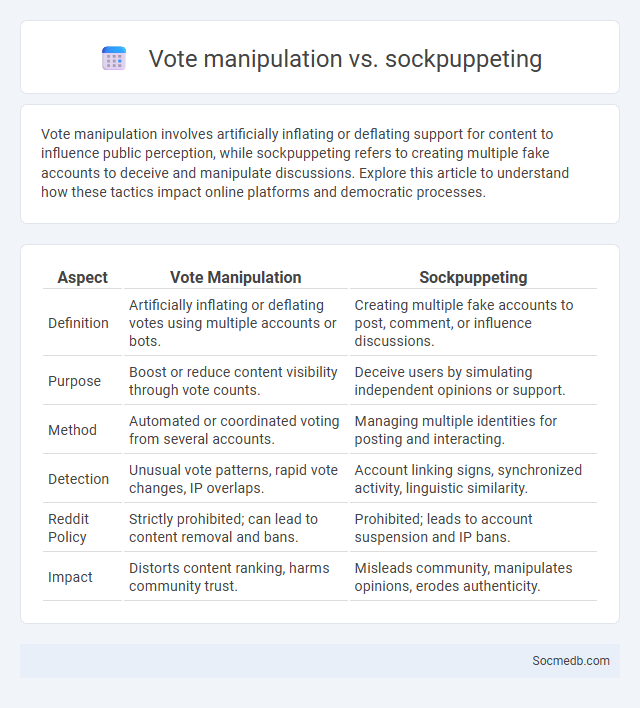
Photo illustration: vote manipulation vs sockpuppeting
Vote manipulation involves artificially inflating or deflating support for content to influence public perception, while sockpuppeting refers to creating multiple fake accounts to deceive and manipulate discussions. Explore this article to understand how these tactics impact online platforms and democratic processes.
Table of Comparison
| Aspect | Vote Manipulation | Sockpuppeting |
|---|---|---|
| Definition | Artificially inflating or deflating votes using multiple accounts or bots. | Creating multiple fake accounts to post, comment, or influence discussions. |
| Purpose | Boost or reduce content visibility through vote counts. | Deceive users by simulating independent opinions or support. |
| Method | Automated or coordinated voting from several accounts. | Managing multiple identities for posting and interacting. |
| Detection | Unusual vote patterns, rapid vote changes, IP overlaps. | Account linking signs, synchronized activity, linguistic similarity. |
| Reddit Policy | Strictly prohibited; can lead to content removal and bans. | Prohibited; leads to account suspension and IP bans. |
| Impact | Distorts content ranking, harms community trust. | Misleads community, manipulates opinions, erodes authenticity. |
Understanding Vote Manipulation: Definition and Methods
Vote manipulation in social media refers to the intentional interference with online polling or voting mechanisms to skew results unfairly. Common methods include the use of bots, fake accounts, coordinated voting attacks, and automated scripts that artificially inflate or deflate vote counts. Understanding these tactics is crucial for maintaining the integrity of social media platforms and ensuring authentic user engagement.
What is Sockpuppeting? Unmasking Hidden Accounts
Sockpuppeting refers to the creation and use of fake online identities to manipulate social media conversations, deceive users, or amplify specific viewpoints. These hidden accounts often impersonate genuine users or fabricate personas to post biased content, inflate followers, or sway public opinion covertly. Detecting sockpuppeting involves analyzing behavior patterns, IP addresses, and content similarities to unmask these deceptive social media practices.
Key Differences Between Vote Manipulation and Sockpuppeting
Vote manipulation distorts content ranking by artificially inflating or deflating votes through coordinated or automated actions, often harming the integrity of platform feedback systems. Sockpuppeting involves creating and operating multiple fake accounts to deceive users or influence discussions, aiming to fabricate consensus or anonymity for deceptive behavior. While vote manipulation targets the voting mechanism specifically, sockpuppeting encompasses broader fraudulent identity tactics affecting social interactions and trust.
How Vote Manipulation Impacts Online Platforms
Vote manipulation on social media undermines content authenticity by artificially inflating or deflating engagement metrics such as likes, shares, and comments. This distortion affects algorithms, leading to biased content visibility, which misguides Your perception of popular opinions and trends. Persistent vote manipulation erodes trust in online platforms, compromising the reliability of information and community interactions.
The Role of Sockpuppets in Skewing Public Opinion
Sockpuppets, fake online identities created to manipulate public discourse, play a significant role in skewing public opinion on social media platforms. These deceptive accounts amplify certain viewpoints, manufacture consensus, and distort the perception of genuine user engagement, leading to misinformation and biased narratives. Research from institutions like Oxford Internet Institute highlights how sockpuppetry campaigns can influence political debates, consumer reviews, and social movements by creating artificial echo chambers.
Real-World Examples of Vote Manipulation
Vote manipulation on social media platforms like Twitter and Facebook often involves coordinated bot networks artificially inflating likes, shares, or comments to sway public opinion during elections or product launches. For example, during the 2016 U.S. presidential election, Russian interference included thousands of fake accounts boosting divisive content to manipulate voter sentiment. Understanding these tactics can help you critically assess trending posts and safeguard your digital interactions from influence campaigns.
Detecting and Preventing Sockpuppeting
Detecting and preventing sockpuppeting on social media involves analyzing account behaviors such as posting frequency, IP addresses, and interaction patterns to identify multiple accounts operated by the same individual. Advanced machine learning algorithms and AI-driven tools can flag suspicious activities, ensuring authentic user engagement and reducing misinformation. Protecting your online community requires continuous monitoring and verification processes to maintain trust and platform integrity.
Ethical and Legal Implications of Vote Manipulation
Vote manipulation on social media platforms raises significant ethical concerns, including the distortion of democratic processes and the undermining of voter autonomy by spreading misinformation or using bots to artificially inflate support. Legal implications involve violations of electoral laws, potential breaches of data protection regulations, and increased scrutiny from regulatory bodies aiming to ensure fair and transparent voting practices. Addressing these challenges requires robust platform policies, advanced detection algorithms, and stricter enforcement of existing election security statutes.
Community Responses: Combating Manipulative Practices
Social media platforms employ advanced algorithms and community guidelines to detect and counter manipulative practices such as misinformation and bot-driven propaganda. User-driven initiatives and fact-checking collaborations enhance the resilience of online communities by promoting authentic interactions and accountability. Engagement in digital literacy campaigns empowers users to critically evaluate content and resist influence operations effectively.
Safeguarding Online Integrity: Best Practices and Solutions
Safeguarding online integrity on social media involves implementing robust privacy settings, regularly updating passwords, and utilizing two-factor authentication to protect personal data from cyber threats. Employing content verification tools and promoting digital literacy helps combat misinformation and maintain authentic interactions. Platforms like Facebook, Twitter, and Instagram enhance security measures through AI-driven monitoring systems that detect and prevent fraudulent activities.
 socmedb.com
socmedb.com